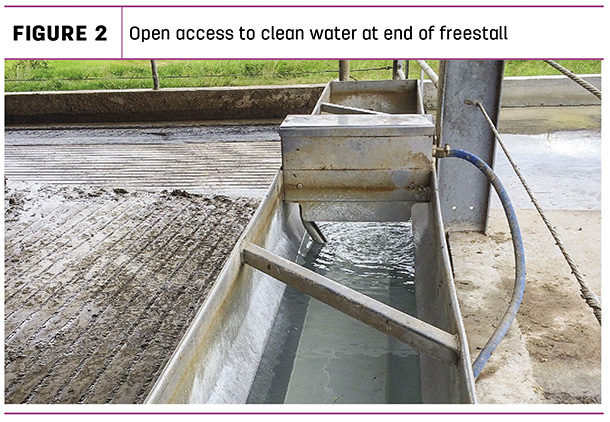We keep a close eye on dry matter intake (DMI) for signs that something is “off” while water intake continues mostly unnoticed in the background. Practical steps can be taken to ensure water intake is not limiting for cow comfort and milk production.
Heat stress is a drain on performance and reduces feed intake, milk production and feed efficiency. Furthermore, heat stress of dry and lactating cows has been shown to reduce performance of the cow, her daughters and granddaughters. Water requirements increase 30% or more during heat stress, and the cow’s water-based internal cooling system requires full hydration to operate at full capacity. Cows cannot remain fully hydrated if water intake is compromised by lack of access, flow or quality.
Water plays a crucial role in heat dissipation through expiration (lungs), evaporation (skin) and excretion (urine) from the body. The water molecule has a uniquely high-heat capacity, which is the ability to absorb and transfer heat, making it ideal for both internal and external cooling of cows.
A classic study in 1969 found that early lactation cows under heat stress (90ºF, THI=75) had increased rectal temperature, reduced feed intake and fecal water output, a 28% increase in water intake and a 50% to 60% increase in skin surface and respiratory evaporation. In addition, the efficient use of digested energy for milk production was reduced by 30%.
The metabolic heat load of today’s high-producing cow is significantly greater than in 1969, so optimum water consumption is even more important in combating heat stress. Heat stress increases the water requirement of cows by 30% or more. High-producing (99 pounds per day) cows require about 30 gallons of water under temperate conditions and 40 gallons or more under heat stress, with an increase in the length and frequency of drinking bouts.
Heat stress is compounded by increased stocking density. Kansas State workers reported that increasing stocking density from 100% to 130% of capacity reduced available water space from 3.6 inches per cow to 2.8 inches per cow in four-row freestall barns and from 2.25 inches per cow to 1.7 inches per cow in six-row barns. Most expert sources cite 3.5 inches of linear water space per cow as adequate, but farm cow comfort assessments have found that, on average, this goal is not being met (Table 1).

As resources per cow shrink, aggressive behaviors by dominant cows increase, including dominant behavior around waterers. Subordinate cows and first-lactation cows are most affected. Excessive time away from pen for milking and/or lock-up times can exacerbate the problem. One answer is more water.
Additional water space can often be added in the return alley (Figure 1), within pens or in outdoor areas.

Waterers have been successfully fabricated from large PVC piping, standard water troughs and plastic barrels. Water from plate coolers can provide additional supply. More dominant cows appear to favor waterers in the return alley, which may reduce competitive pressure at waterers in the pens. Studies show that dairy cattle spend only 20 to 30 minutes per day drinking water but normally drink most of their water after milking and feeding. Increased water space can help alleviate the bottleneck in water access during preferred drinking times, which is compounded by heat stress.
A survey of 133 commercial dairies found that rolling herd average (RHA) milk yield was positively related to linear water space (+225 pounds per inch), to the use of water cups or fountains in addition to tanks (+989 pounds) and to the regular cleaning of water devices versus never cleaned (+2,278 pounds). A study of 22 Canadian freestall herds reported that each additional inch of linear water space was associated with 2 additional pounds of milk per day. In a study of 204 Norwegian freestall herds, milk yield of first-lactation cows increased with more easily accessible water troughs. Across all lactations, yearly adjusted milk increased by 507 pounds per cow when available water space was greater than 3 inches per cow (80% of recommendation). These findings reinforce the value of ample water space, easy access and cleanliness (Figures 2, 3 and 4).



Cows spend more time and drink more water from water troughs that are higher (24 versus 12 inches) and with a larger surface area (12 versus 3 cubic feet). Water depth and refill rate should maintain water volume during peak drinking times (no slurping sounds). Rails to prevent cattle from stepping into troughs (Figure 5) should allow at least 21 inches of head clearance for cows drinking.

Depending on plumbing configurations, water intake can be monitored by water meters isolating pens or barns.
Water quality is addressed in excellent reviews. Periodic water tests are worthwhile to detect any significant changes in quality. Elevated water nitrate had a negative effect on both RHA milk yield (-18 pounds) and calving interval, and was associated with drilled wells less than 100 feet deep. Although high levels (greater than 3,000 ppm) of total dissolved solids (TDS) are cited as a concern for reduced performance, research in 2021 found that saline or brackish water up to 6,000 ppm TDS was well tolerated by beef cows and heifers. Heat-stressed dairy cows produced more milk but similar yields of fat and protein when consuming water with 900 versus 3,400 ppm TDS while water consumption was not affected.
Elevated levels of sulfate and chloride can be a concern in lactating cows and should be monitored. High levels of water sulfate can reduce trace mineral absorption. Performance and health of feedlot cattle consuming high-sulfate water was improved when organically chelated zinc, copper and manganese were fed in place of inorganic sources. Water palatability can be reduced by elevated levels of manganese and iron. Algae growth in water tanks should be avoided through regular cleaning and by providing shade over outdoor waterers. Some species of blue-green algae can produce toxic levels of cyanogenic compounds, while other algae are simply unpalatable to cattle and can reduce water intake.
The 2021 National Research Council (NASEM) Nutrient Requirements of Dairy Cattle has an excellent chapter on water requirements and dynamics in cattle that includes new predictions for water intake requirements of cows based on production level, diet and environment.
Unrestricted access to clean water is a crucial component of dairy cattle nutrition, health and performance, especially during heat stress. Location and design of water stations should consider cow numbers, stocking density, production level and natural behaviors to encourage optimum water intake. Don’t forget calves, heifers and dry cows as well.







